

American cities and their suburbs were built on innovations in transport technology. The spatial imprint of car ownership is so apparent it led urban activist Jane Jacobs to question whether American cities had in fact been built for people or for cars. In the past five years, a digital-hybrid layer of urban mobility has emerged—a fleet of autonomous, self-driving, car-pooling, electric vehicles have been set in motion. Google’s Waymo project is now driving 25,000 autonomous miles each week, and the net worth of the automated vehicle (AV) industry is projected at $7 trillion. This month I discuss how architects can participate in this emerging technology with architect and Yale professor Keller Easterling and Carlo Ratti of MIT’s Senseable City Lab. Will the uptake of AV’s deter people from public transit, pressurizing motorway expansion, or will we instead create an architectural switch, for a smarter, more equitable transport network?
At the 1939 World Fair in New York, a future for America was unveiled by General Motors. The promotional film ‘Futurama’, shown at the interactive exhibition ‘Highways and Horizons’, presented onlookers with a vision of the nation in 1960. The choking congestion of the industrial city had vanished to make way for automated six-lane expressways which snaked through vast suburbs that stretched far out over the Great Plains. The scene, comparable to that of a breezy country drive in a luxury car advert, presented a vision of efficiency and safety. It was a future powered by technological progress in the transport industry. “The accelerating rate of men’s progress in all fields of endeavour has parallelled closely our progress in the freedom of movement from place to place,” the narrator asservates from a bygone era, “new places to go, and new means of getting there ... in a world which will always move forward.”
In response to General Motor’s brief to inspire public enthusiasm and support for the extensive motorway construction projects being planned at the time, head designer of the exhibit Bel Geddes put the car at the centre of shaping the America of the future. It was to be both a democratising and liberating force, which connected distant families, grew industries, provided jobs and made the country ‘flow’. He could not have predicted that the same technology would soon completely revolutionise the nature of the built environment, the landscape, and even the atmosphere.
By 1961, the same year Jane Jacobs’s magnum opus ‘The Death and Life of Great American Cities’ was published, activists were pushing back at the same planning policies that had created vast highways and choked inner city districts with car traffic. Angered by the human effects of prolific urban decline and fearing the monotony of a city experienced only through the car window, they argued that the national planning policy—which filters through to what is built and where—had been manipulated by the wealthy and influential automotive industries, whose bottom line was to sell more cars.
“The accelerating rate of men’s progress in all fields of endeavour has parallelled closely our progress in the freedom of movement from place to place [...] New places to go, and new means of getting there [...] In a world which will always move forward.” —Extract from General Motors 1939 World Fair Exhibit in New York
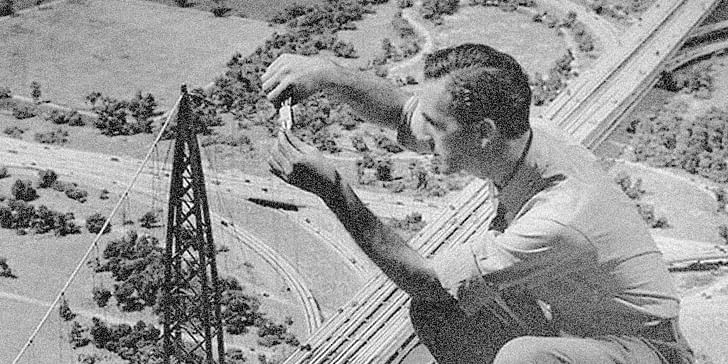
In 2017, as more states continue to legalise AV’s on public roads, the automotive industry has positioned itself at the forefront of the Fourth Industrial Revolution; which might broadly be characterized by an amalgamation of the digital, the physical, and the biological. Data and digitization is disrupting how we produce, manage and govern our societies at an exponential rate. The AV, a fully automated solution for the personal car, is bringing artificial intelligence directly into the city. Inside the AV, sensors collect information on the driver's tiredness, passenger’s stress levels, the temperature and humidity, while laser scanners outside monitor the road and immediate context to analyse and respond in real-time. Individual cars are now interconnected through a myriad of feedback loops into a self-learning global network, the science fiction of Bel Geddes' time.
Many AV integration programs, such as Google’s Waymo project, are being promoted on the grounds of improving the safety and efficiency of existing cars. AV’s, they argue, will not only cut down on wasted fuel due to people taking inefficient routes, but will also decrease the numbers of people dying on the roads (“Get rid of human behaviour to save the human body!”). There is also debate whether AV technology is being released prematurely, with significant risks, highlighted here by guerilla road painters. Yet this is not slowing down rollout. According to IHS, a firm which provide automotive forecasts, AV sales will boom in 2025 and could reach 11.8 million by 2035, and after 2050 almost all vehicles will be autonomous.
Experts agree that this wave of automation combined with a shared car-ownership model will radically alter how we design and build cities, yet what form this will take is hotly contested. In the WSJ, technology columnist Christopher Minns fears AV technology will increase urban sprawl, while a new study by MIT’s Center for Real Estate predicts city cores will densify while their suburbs will scatter. At Bloomberg, Patrick Clark suggests that reclaimed parking spaces—no longer required due to roaming AV’s—will fuel a downtown construction boom, with former street parking to be converted into wider sidewalks and bike lanes. The Real Trends Report published by the Center for Urban Real Estate in Columbia suggests AV’s will instead encourage developers to push deeper into the exurban fringe, due in part to digital workers being able to tolerate longer commutes as they no longer have to drive themselves.
“I agree with Robin Chase, founder of Zipcar, when she says ‘simply eliminating the drivers from cars, and keeping everything else about our system the same, will be a disaster’" —Carlo Ratti, MIT Senseable Cities Lab
So will AV technology increase the number of cars on the road, compounding issues already associated with excessive car use? I catch up with Italian architect Carlo Ratti, founder of the ‘Senseable Cities Lab’, a MIT think-tank aimed at predicting the ‘real-time city’. He suggests future transit will begin to blur the boundaries between public and private. “Your car,” he tells me, “could give you a lift to work in the morning and then, rather than sitting idle in a parking lot, give a lift to someone else in your family, or, for that matter, to anyone else in your neighbourhood, social-media community, or city.” He suggests as a result of this sharing economy we might expect a fraction of the vehicles on the roads in the future as compared to today.
Writing in Switch for E-Flux, architect and Yale professor Keller Easterling suggests that greater access to hands-free rides may in fact push public-transit passengers toward AV’s, causing the number of cars on the road to skyrocket. This, she argues, slots into political motives for “Eisenhower-era highway plans and environmental deregulation to meet the newest shiny technologies.” Ratti also fears a dystopian scenario: “The impact of autonomous vehicles on cities is not predetermined and will depend on the policy decisions we will take. I agree with Robin Chase, founder of Zipcar, when she says ‘simply eliminating drivers from cars, and keeping everything else about our system the same, will be a disaster.’”

Habits are hard to see and harder to shift—the personal car is not only deeply embedded in our culture and psychology, but also in how our cities and buildings are imagined and realized. In 2015, 24% of homes built in the United States included personal garages for three or more cars; taking up a significant proportion of the overall house footprint. Twentieth-century modernism cannot be understood without the idealism of the personal car, the aspirational armchair which transported the family from the bustle and soot of the industrial city to the fresh air of suburbia, and the structured and predictable life it promised.
There are countless cases of homes being designed for, and by, the proportions of the car, a famous example being the ground floor of Corbusier’s Villa Savoye, its curves defined by a car’s turning circle. Various architects over the years have also turned their hands to automotive design, one of the first being Buckminster Fuller’s Dymaxion Car, and more recently car body models by Norman Foster and Zaha Hadid.
In a bizarre recent turn of events, the automotive industry is now trying their hands at designing homes. Symbioz, a self-driving car-home by Renault, integrates the AV—quite literally—into the house. In a future where “car and living space are blurred,” they proclaim on their website, “a new form of freedom will emerge: an autonomous and connected future." Their promotional video demonstrates the AV being elevated from the living room on a piston-like structure to then be parked on the roof for the night. The film then pans out to reveal an absence of context, a promise of an autonomous lifestyle—a technological utopia, reinforced by a new wave of AV’s.
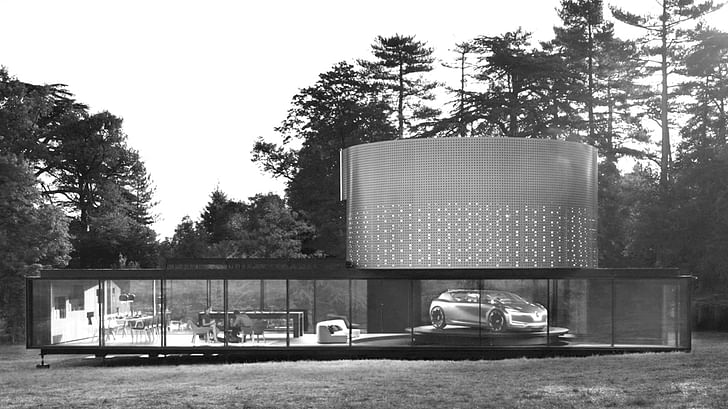
If the gas station, multi-story car park, drive-thru, mall, and suburbia were all parts of the architecture of the auto revolution, what is the architecture of digital mobility? In recent years, despite the automotive industry once again undergoing a paradigm shift, many changes have been difficult to spot, due in part to the focus on online innovation. Apps like ‘Uber’ and ‘Lyft’ have equipped existing cars with integrated computers and driver profiles, while on the street it appears that not much has changed. However, the recent focus on AV’s has been at the expense of other modes of digital mobility. Automated subway networks, micromobility, logistics drones, and self-driving buses are arguably no less viable than AV’s, yet, while we can summon a car from the street using our phones, we are still summoning a car.
“Twentieth-century modernism cannot be understood without the idealism of the personal car, the aspirational armchair which transported the family from the bustle and soot of the industrial city to the fresh air of suburbia, and the structured and predictable life it promised.”
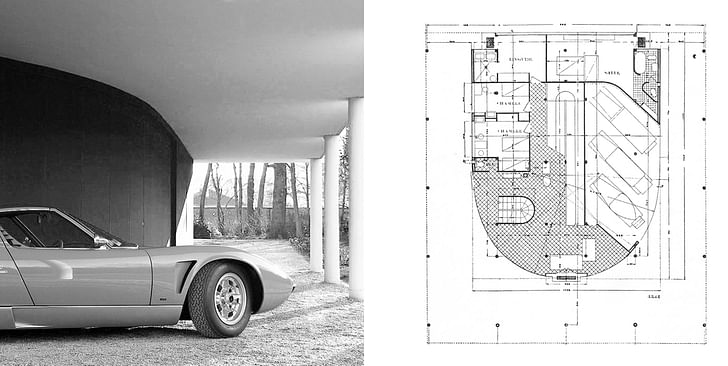
During our discussion, Keller Easterling explains she began thinking about digital mobility and automation in the future car industry in the 1990s when she was researching highway design for her book ‘Organisation Space’ (1). She suggests that in the “digital euphoria” of the late-20th century there was a sort of amnesia for other forms of information systems, such as physical space. This led her to consider the potentials of intermodal switching for highways. “I was really surprised,” she explains, “that in some early incarnations, Google and the other AV companies were making a vehicle that would be sold like an ordinary car to put in your garage. It was amazing to me that nobody talked about the size of the car in large aggregations if everybody was on the road, in lieu of transit.” She continues, “nobody was talking about that. So AV’s prompted another application of the switch idea.”
For Easterling, the car is an example of a multiplier, an individual device that when upscaled has enormous spatial consequences. “I had studied highways for a long time as well as automated port logistics,” she explains, “and I was fascinated by the transfer of automation technologies from container fields to passenger vehicles like driverless airports or parking-lot shuttles. Digital and spatial information systems can either make each other dumber, or make each other smarter,” she explains. “If the industry continues organising investment and innovation as it is doing now, we will end up with a very smart vehicle in a very dumb traffic jam. A spatial switch can make transfer between both transit and fleets of automated vehicles much more robust while also handling the complicated itineraries of people’s lives. A physical, urban volume can make a digital information system smarter.”
“If the industry continues organising investment and innovation as it is doing now, we will end up with a very smart vehicle in a very dumb traffic jam.” —Keller Easterling
To understand spatial switches, Easterling suggests you must first back out from the individual design brief into an information-rich medium to view interconnected systems “in their messiness, their richness and robustness.” From this perspective, the aim is to view not only the object but also the relative potential of all moving parts in the matrix. “Switch,” she continues, “is an experiment in ‘medium design’—inserting spatial changes that only an architect or urbanist might know about to rewire urban relationships.” While architectural solids are as much a part of this as alterations in networks and relationships, she suggests all are underexploited mediums of intervention. This is where architects come in—due to their skills at rewiring the ‘chemistry of the space’.
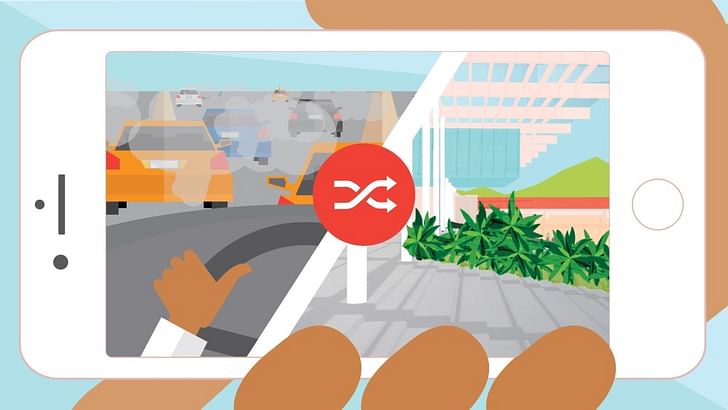
In the studio, Easterling underlines the importance of working on a macro-organisational level—that which holds the power to influence governance—while continuing to design spaces and buildings. When she set ‘Switch’ as the brief for a seminar on architecture and entrepreneurialism, she found her students were working on different kinds of social, political and commercial enterprises. “We looked at the actual urban space of the switch” she tells me, “but we also looked at other spatial consequences of AV switching like the configured space in suburbia and cities—what happens to roadway capacities, parking space and garages. Students also worked on mini-institutions in communities, suburbs and cities—smaller switches or neighborhood substations to organize the last mile of walking, running or biking home. We thought about how these and the larger switches might ease choke points in people’s impossible schedules—how they might organize childcare, home office work, making dinner or organising the landscape. How also might this shift contact populations who are perennially deprived of mobility?”
I caught up with a group of three former students who have now taken ideas explored in class further as an entrepreneurial venture in California. Brian Cash, Nathan Portlock and Miguel Sanchez-Enkerlin together co-founded ‘The Shift’, a platform to solve problems in urban planning and real estate that they predict will arise with the mass deployment of autonomous vehicles. From their analysis of mobility data from both Los Angeles and San Bernardino, California, they are now proposing to create ‘multimodal transportation hubs’, nodes linking existing rail infrastructure, conventionally operated vehicles and bicycles with AV’s. Their proposition preempts the boomerang effects of AV’s and adds to the ecosystem of services possible within the next transportation revolution, which is particularly interesting when applied to growing economies in China or India.
“In addition to master plans or buildings, we might also be good at altering the wiring or chemistry of space.” —Keller Easterling
In March of this year, a team of design consultants put together the white paper ‘Driverless Future: A Policy Roadmap for City Leaders’, giving urban designers and policymakers key points to consider as cities adapt to AV’s. An aim of this feature was to offer a series of points for architects, however, given the multiplicity of futures proposed by those well versed in how digital mobility will affect our built environment, I offer a series of thought experiments instead:
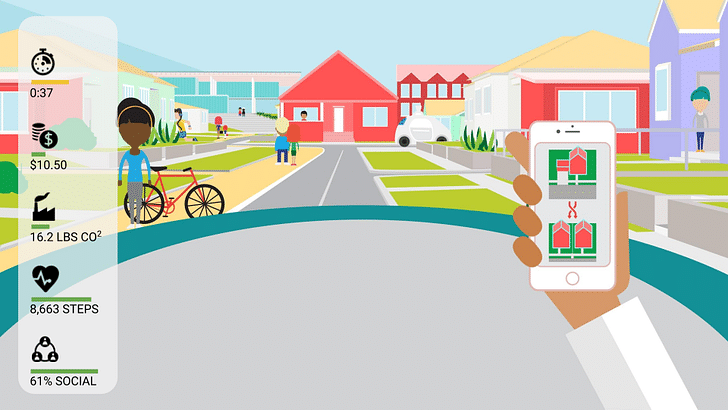
“This is trying to put [young designers] in the driver's seat as the ones who are having ideas and going directly to culture with them. They are not going through policy, not through municipal governance or clients or just being advocates, they are entrepreneurs, public voices—pop culture.” —Keller Easterling
Each month, I explore a technological change that will reshape how future architects will practice, yet a stumbling block I often come up against is what agency do architects realistically possess in writing their own briefs? Yes, we can consider other ways of doing things, but how do the commissions come through? “There are many different kinds of ventures and enterprises linked to spatial practice,” suggests Easterling: “I’m arguing these are not just marginal or alternative practices but ones that are potentially much more robust and much more sustainable than the kinds of practices on which we rely at the moment. I want younger people who are about to leave school to have a chance to rehearse these sort of enterprises. It is not about policy studies or about waiting for clients or governments to act. It is about an artful design advocacy or entrepreneurialism that even builds an audience in popular culture.”
What might result when, rather than trying to replace a problematic piece of technology with something new, but of the same nature, architects begin to rewire the network? The last mobility revolution had an effect greater than the sum of its parts. Could the digital mobility revolution do more than getting people and goods from A to B, but also generate choice and equity for people? Might it instead form an interplay between digital and human networks through information and choice? This might present itself in a shift in habits of mind, or in the disposition of power in cities. “I think it is a moment for architects to demonstrate the importance of a spatial variable like the switch,” suggests Easterling. “In fact it is almost too late. It’s such a huge change, with a potentially enormous morphological buckshot not only in the suburbs but also in the cities.” I agree, the technology is here, it is already on the road, but how will we intervene?
“I think it is a moment for architects to take a stand. In fact I think it is fast-coming, almost too late. You know, it’s time to do it.”— Keller Easterling
(1) Organization Space: Landscapes, Highways and Houses in America, MIT, 1999.
Hannah is an architect and writer based in Tanzania, East Africa. Her monthly feature column for Archinect, 'Architecture Futures', explores the technological developments currently shaping the architecture profession within wider cultural and political discussions by bringing together critical ...
No Comments
Block this user
Are you sure you want to block this user and hide all related comments throughout the site?
Archinect
This is your first comment on Archinect. Your comment will be visible once approved.